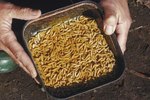
If you want your turtles to thrive, they need a pond with a mud bottom, as opposed to the granite you might use in an ornamental pond. Your turtles also will benefit from materials that emulate their natural habitat, such as rocks and driftwood. Unfortunately, the ideal turtle habitat is also ripe for leeches. Getting rid of the leeches is important for the health of the turtles.
One Thing You Must Not Do
The easiest way to get rid of leeches is to douse the pond with a chemical treatment, such as an insecticide. However, since your pond is home to turtles as well as leeches, it’s imperative that you avoid this course of action. Any product designed to kill leeches or other pond pests will be harmful to the turtles too.
Let Nature Handle It
Leeches have a number of natural predators and of those, a handful will be suitable for introduction into your turtle pond. Large mouth bass, mallard and wood ducks and the yellow bullhead catfish will eat or eradicate the leech population. You may wish to remove your turtles temporarily while the predatory pest controller is in place. Depending on the size of your pond, you might consider making the new predator a permanent addition to the turtle pond ecosystem, but check first that it won’t pose a threat to the turtle. For example, if lots of ducks are living in the pond, they can cause algae to grow, which is potentially harmful to turtles. Turtles are also leech eaters, so you could introduce more turtles to the pond to help the residents to control the leech population, but that might be an expensive or unsuitable solution.
Manual Removal
If your leech infestation is minor, you can simply remove the leeches by hand. Be sure to wear a pair of latex gloves to prevent these little bloodsuckers from feasting on you. Half-fill a bucket with some pond water and set it aside at the edge of the pond. Reach in and pull the leeches out. They’re most likely to be found nestling in the muddy bottom of the pond, on rocks and attached to the side of the pond in shallow areas. Pop the little critters into the water. Leeches reproduce in the spring, so during spring and summer, you’ll need to remove the cocoons as well to prevent a reinfestation.
Set a Trap
Drill a series of small holes inside a metal can and bait it with meat. This will attract the leeches. Periodically remove the trap from the pond and check for leeches. If you spot any, put on some gloves and remove them and submerge the trap.
Drain the Pond
If it’s winter, you can freeze the leeches in mud. If you drain the pond, the leeches will not be able to leave the muddy bottom. Once the mud freezes, the leeches will die. However, this solution may kill any other pond dwelling burrowers, such as frogs.
References
Photo Credits
-
Ryan McVay/Photodisc/Getty Images
Writer Bio
Simon Foden has been a freelance writer and editor since 1999. He began his writing career after graduating with a Bachelors of Arts degree in music from Salford University. He has contributed to and written for various magazines including "K9 Magazine" and "Pet Friendly Magazine." He has also written for Dogmagazine.net.




